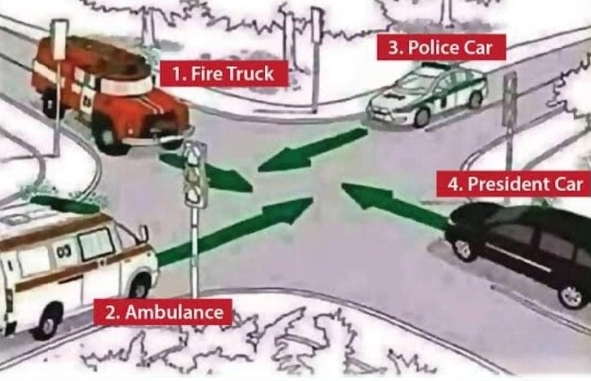Imagine a high-pressure moment: four emergency vehicles—a fire truck, an ambulance, a police car, and the President’s motorcade—arrive at an intersection simultaneously. Each is on an urgent mission, but there can only be one priority. How do you decide who goes first? It’s not just a casual question; this scenario tests your ability to analyze, prioritize, and think critically.
Let’s dive deep to determine the top priority in this case and understand the reasoning behind it.

Breaking Down the Challenge
At first glance, you might instinctively choose the ambulance or the President’s car. Both seem critical, right? But this puzzle demands logic, not assumptions. To solve it, we need to consider the roles and urgency of each vehicle. Each serves a specific purpose in emergencies, and understanding their priorities can lead us to the right answer.
Common Mistakes in Prioritization
People often struggle with scenarios like this because they rely on snap judgments. Let’s explore the typical errors that can derail decision-making:
1. Defaulting to the Ambulance
Many assume that the ambulance must go first. After all, it’s usually transporting someone in critical condition. But emergencies are complex, and other vehicles, like fire trucks or police cars, may have an even greater immediate impact.
2. Prioritizing Status Over Urgency
The President’s car often feels like the obvious choice due to the individual’s significance. However, life-saving and disaster management efforts take precedence over personal status in emergency protocols.
3. Overlooking Context
Some people forget to consider the larger picture. What’s the role of each vehicle in this specific scenario? Missing these contextual details can lead to flawed decisions.
4. Thinking All Vehicles Are Equal
While it’s tempting to view all emergency vehicles as equally important, they operate under a structured priority system. Allowing them to move simultaneously can cause confusion and chaos.
Step-by-Step Analysis: Finding the Right Priority
To determine the top priority, let’s analyze each vehicle’s role and urgency.
1. Fire Truck: Leading the Charge
A fire truck’s mission is to tackle fires, prevent their spread, and rescue individuals in immediate danger. Fires are unpredictable and can escalate rapidly, posing a threat to lives, property, and infrastructure. Delaying a fire truck can result in catastrophic consequences.
Why the Fire Truck Goes First:
Time is critical when combating fires. The fire truck takes top priority because its role directly prevents widespread damage and saves lives.
2. Police Car: Securing the Scene
Police vehicles play a vital role in ensuring public safety. They secure intersections, manage traffic flow, and support other emergency responders. Police might also handle threats or assist in creating a safe environment for the fire truck and ambulance to operate effectively.
Why the Police Car Goes Second:
After the fire truck clears the way, the police car ensures the scene remains controlled. Their presence minimizes the risk of accidents or interference, allowing the other vehicles to proceed safely.
3. Ambulance: Delivering Critical Care
Ambulances transport patients in urgent need of medical attention. While their mission is crucial, ambulances often rely on the fire truck and police to clear safe paths for uninterrupted travel.
Why the Ambulance Goes Third:
Once the fire truck and police car have paved the way, the ambulance can proceed without delays or risks. This sequencing ensures a smoother, faster journey to the hospital.
4. The President’s Car: Last, But Not Least
The President’s car is undoubtedly important, carrying one of the nation’s most protected individuals. However, it’s rarely tied to immediate life-or-death emergencies. Presidential security protocols are robust, allowing flexibility to accommodate slight delays.
Why the President’s Car Goes Last:
Emergency responders prioritize saving lives and managing disasters over the President’s travel needs. The motorcade can afford to wait until the other vehicles have addressed their critical missions.
The Final Priority Order

To summarize, the correct sequence is:
- Fire Truck
- Police Car
- Ambulance
- President’s Car
This order reflects established emergency protocols designed to save lives, maintain order, and maximize efficiency.
Why Prioritization Matters
This exercise isn’t just a mental puzzle; it’s a real-world example of how emergency services coordinate during high-stakes scenarios. Prioritizing incorrectly can waste precious time, endanger lives, and create unnecessary chaos.
By understanding the roles and responsibilities of each vehicle, we see the importance of structure and reasoning in decision-making.
Lessons From This Challenge
What can we learn from this exercise? Here are some key takeaways:
- Think Beyond Instinct: Initial assumptions often overlook critical details. Analyze the situation logically.
- Understand Context: Each emergency is unique. Context determines who takes priority.
- Value Coordination: Emergency services thrive on structured teamwork. Without it, chaos reigns.
This scenario reminds us that attention to detail and logical thinking can lead to better decisions—not just in emergencies but in everyday life as well.
What Would You Do?
Now that you know the answer, how did your initial guess stack up? Were you surprised by the reasoning behind the correct order?
Take a moment to reflect on how you approached the problem. If this scenario caught you off guard, share it with friends or family and see how they respond. You might be surprised at the variety of answers—and the discussions it sparks!
Conclusion: A Lesson in Critical Thinking
Determining the top priority in this scenario wasn’t about favoritism or guesswork. It was about understanding the unique roles and urgency of each vehicle and applying logical reasoning.
This exercise highlights the importance of prioritization in emergencies and beyond. Whether it’s deciding who goes first at an intersection or tackling complex challenges in life, the key is to stay calm, assess the situation, and think critically.
Next time you’re faced with a tough decision, remember this puzzle. It’s a perfect reminder that the right choice often lies in the details—and those who take the time to analyze them always come out ahead.